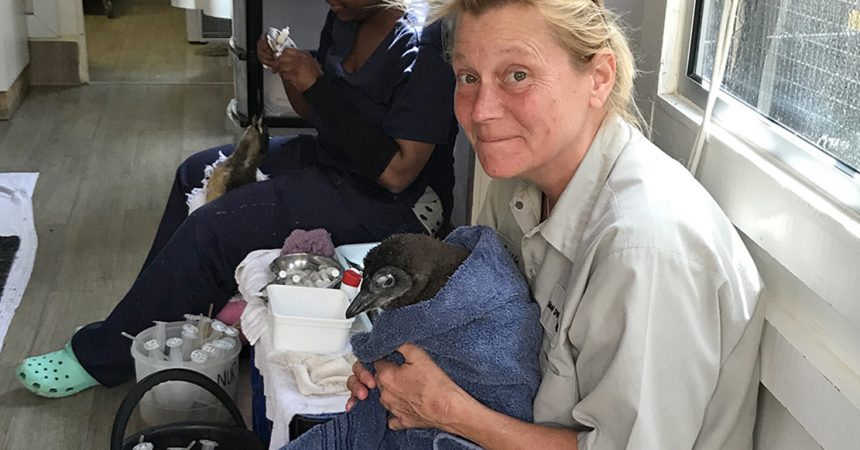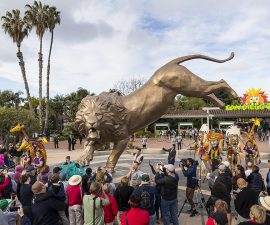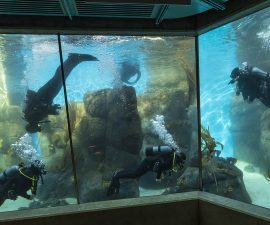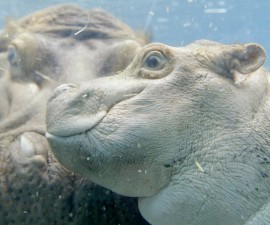I’m not sure what I was expecting, but it certainly wasn’t what was in front of me. The building was old and small, the property around it not much larger. Behind the chain link fence reinforced with netting and roofed over by corrugated plastic, I heard the familiar sound of hoses showering concrete, and I smelled the familiar, overpowering smell of penguin. As I stood in front of the ramshackle facility, I thought, “Surely, this can’t be the place I’ve heard about. How on earth can they manage?”
I had first heard of SANCCOB, The South African Foundation for the Conservation of Coastal Birds, in 2000, while I was caring for the largest collection of penguins in any zoo—and falling in madly in love with the animals. In June 2000, the MV Treasure sank off the coast of Cape Town, South Africa, spilling over 1,300 tons of oil and resulting in one of the most catastrophic environmental disasters in that nation’s history. The oil spill occurred near Robben and Dassen Islands, home to the largest and third-largest colonies of African penguins, a species found only in South Africa and nowhere else in the world. SANCCOB, in partnership with the International Fund for Animal Welfare (IFAW), was responsible for the successful rescue, cleaning, rehabilitation, and release of nearly 19,000 African penguins back into South African waters. In addition, another 19,000 un-oiled penguins were collected from the colonies and relocated miles away from the spill on the eastern cape; calculations for timing their migration home would give the oil-spill responders enough time to clean the spill before the penguins reached home, and they were correct. SANCCOB’s rescue efforts saved nearly 36,000 penguins in a little over 12 weeks.
The San Diego Zoo is a member of Association of Zoos and Aquariums (AZA), Saving Animals From Extinction (SAFE) coalition. As a partner of AZA SAFE we help fund and participate in conservation-directed field work as well as engage the public about conservation work being done locally and around the globe. As part of our partnership, we have committed to sending volunteers to SANCCOB for the next several years to assist with penguin rescue efforts during their busiest season. In 2017, I was chosen to be part of the San Diego Zoo team to travel to South Africa and assist SANCCOB in chick rearing, to strengthen and support our relationship with the rescue organization, and to share my personal story when I returned home.
We started our first day at the rescue as each day would begin. At the morning meeting, new volunteers would introduce themselves and would share what drew them to volunteer at SANCCOB. We would get an update from the staff on what we could expect that day—new admissions, possible releases, medical checkups, weight updates, and wellness assessments. Lastly, the volunteers would receive their assignments for the day. Two or three volunteers were assigned to each of the many pens containing anywhere from 30 to 60 chicks. The pens were organized by the developmental stage of the chicks: small fluffy chicks, larger fluffy chicks, very sick chicks who needed medical attention, partially-molted chicks, mostly molted chicks, and fully molted chicks—who were allowed to swim for 5 minutes, 20 minutes, or for a full hour.
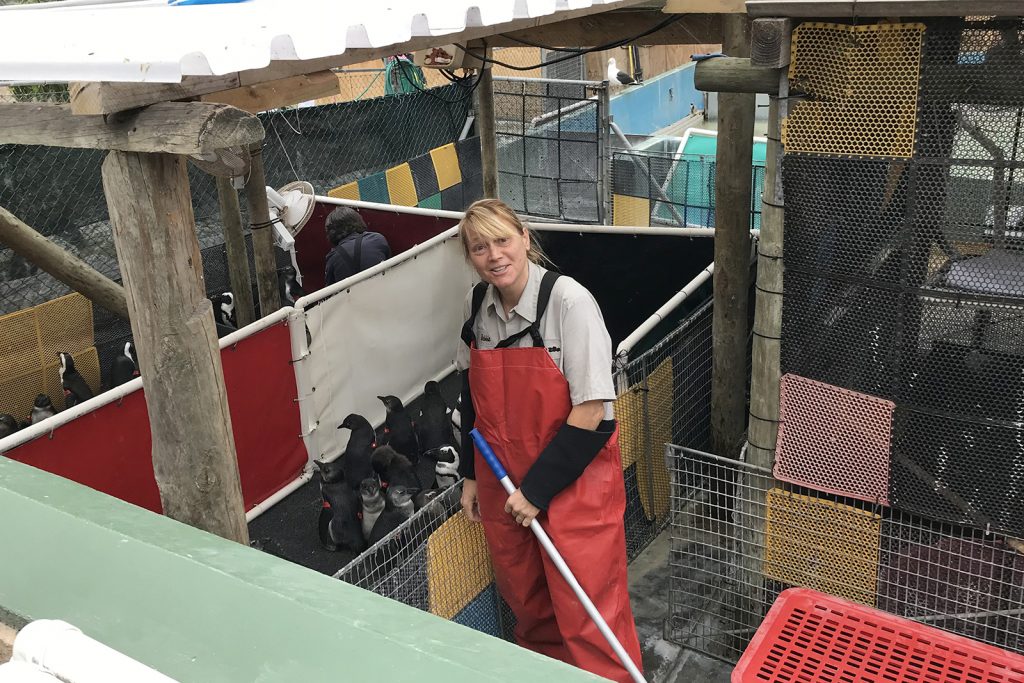
Keeping it clean is a labor of love.
The daily routine was the same for each pen regardless of the stage of the chick; the morning began with electrolyte tube feeding for everyone, followed by a thorough cleaning of the pen. After cleaning, a tubed formula and forced fish feeding was done, followed an hour later by a tubed water feeding. After lunch, there would be organizing and coordinating which birds needed to swim, which needed to be nebulized, and which chicks were moving into another pen. Medications needed to be prepared for the following day; laundry needed to be done; and the crew assigned to General Duty always needed help making formula or washing the endless brigade of buckets, containers, and syringes used throughout the day. In late afternoon, there was another formula and fish feeding, record keeping, and a final cleanup. We finished the day with a debrief and a heartfelt thank you from the permanent staff for a job well done. Then we would do it all over again the next day.
If this doesn’t sound daunting enough, let me offer this: the primitive conditions I observed from outside of the facility were mirrored on the inside. One hose bib was shared by everyone, split among the many pens needing to be cleaned. The large pool used to prepare chicks for their life as a seabird didn’t actually have a drain, but was emptied by a sump pump, that usually failed a few times a week. There were no sinks with running water; instead, we filled large buckets to clean and disinfect used syringes and containers. A bathtub was available to clean buckets and larger items. Without sinks with running water to thaw the day’s fish diet, this was done in large plastic tubs. Two small washing machines ran nonstop to keep up with the amount of laundry, and most of that laundry was hung on a clothesline to dry. Quarters were close— you most likely had to step over or duck under someone or something to get where you needed to be.
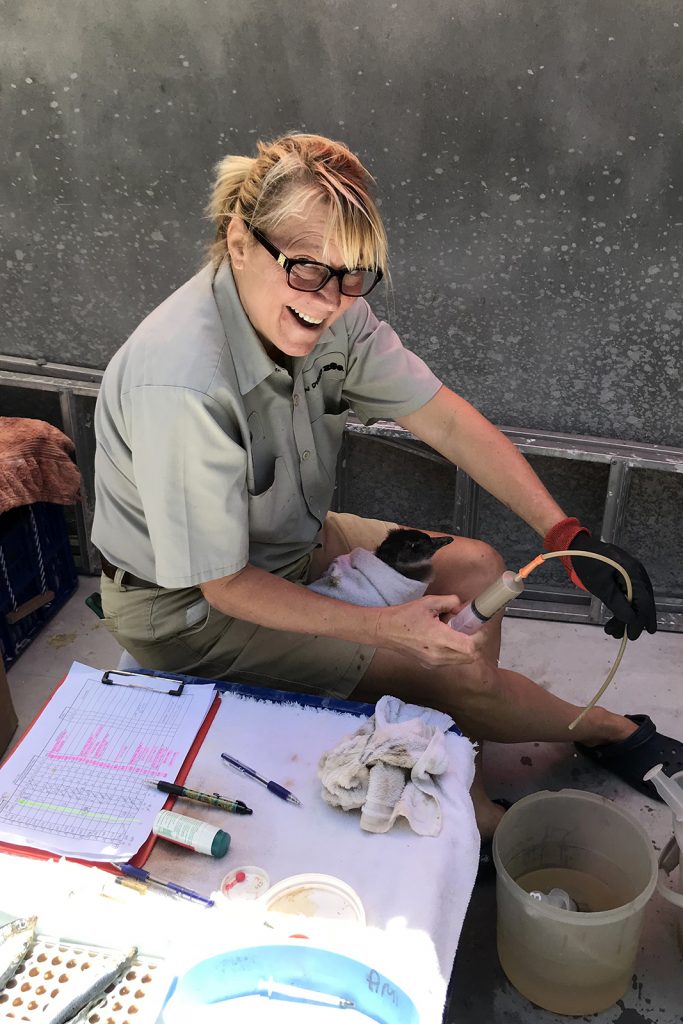
So many hungry beaks to feed…and keep track of!
And yet, I never heard a single complaint from anyone about the lack of modern day conveniences. The group of volunteers of every age, from every corner of the globe, and every experience level—from novice penguin fan to seasoned penguin wrangler—teamed together every day, and made it work. We all understood the importance of the work we were doing; we understood the threats and challenges to the wild population. We knew the impact our work would have on the wild population, and doing this work successfully was more important than the inconvenience of limited resources.
But what were we doing? You didn’t hear of any oil spills, right? So, why was what we were doing so important? I think I might need to backtrack a bit.
When the Treasure oil spill occurred, the population of African penguins was estimated to be near 179,000 animals. The population has been in a steady, rapid decline for nearly a century, so much so that an oil spill of that magnitude today could potentially wipe out the species entirely. Its estimated that today’s population numbers near 23,000 breeding pairs, slightly more than the number of animals rescued and saved during the Treasure oil spill. Oil spills near Cape Town continue to be a constant threat, but the biggest threat to the penguins now is the unavailability of prey. This is where our work at SANCCOB comes into play.
Warming oceans are changing the currents that swirl around South Africa. African penguins used to be able to leave their nests, catch some lunch and return with full bellies to regurgitate-feed their youngsters. Now, shifting currents are redistributing sardines and anchovies further and further away from the breeding colonies, forcing the penguins to swim farther and search longer for meals. When they finally do return home, there’s much less in their bellies to feed; therefore, the chicks are growing at a much slower rate. Penguins will molt after chick rearing but that’s dependent upon seasonal cues, so if Mother Nature tells the birds to molt, they do—which means they stop feeding their chicks, which starve and eventually die. A few years back, SANCCOB recognized this problem and started to rescue abandoned chicks to finish doing what the parents could not. Last season, SANCCOB raised and released over 500 African penguin chicks that otherwise would have died. Since the inception of the Chick Bolstering Project in 2006, they have released more than 4,000 chicks. And for a population of animals we are in danger of losing so quickly, every individual matters.
World Penguin Day is Wednesday, April 25, and you’re invited to join us in celebrating at the Zoo’s newly opened Conrad Prebys Africa Rocks with special activities and presentations. If you can’t join us in person, get a glimpse of our energetic colony on Penguin Cam.
Debbie Denton is a keeper at the San Diego Zoo.

